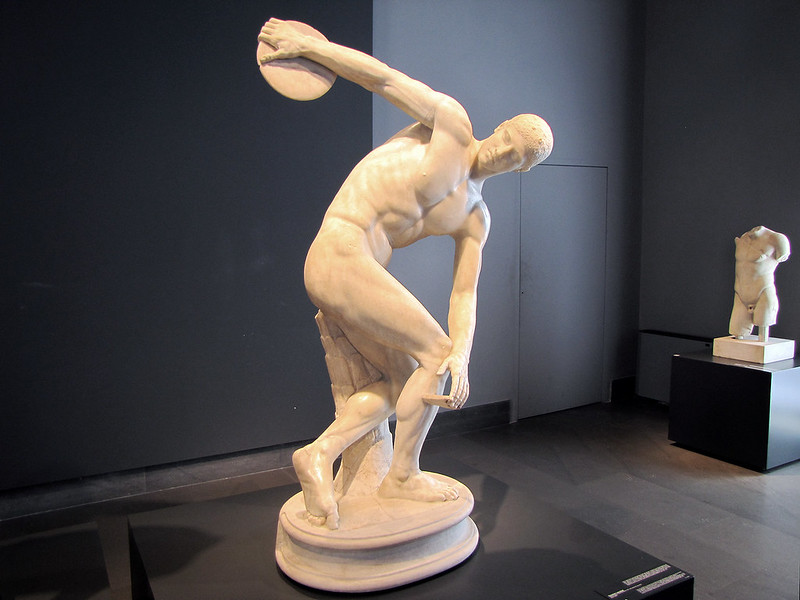
Although the Olympic Games in ancient Greece were very different from those we have today, ancient athletes accomplished many incredible athletic feats. But what diet did these ancient athletes and Olympians follow?
Early in the history of the Olympic Games, which began in 776 BC, the diet of ancient Olympians was not differing to that of typical ancient Greeks.
The ancient Greek diet, somewhat surprisingly, was mostly vegetarian. The vast majority of Greeks, even those in the higher social classes, did not consume red meat or even poultry on a daily basis.
Ancient Greek diet was mainly vegetarian
Many meals consisted of barley porridge, (as wheat was considered unhealthy and decadent), along with cheese, fresh vegetables, and seasonal fruits of some kind with figs being the most popular fruit in antiquity.
In fact, the sweet little fruits were an essential part of the diet of Charmis, a Spartan athlete. Fascinatingly, records of Charmis’ diet provide us with the earliest details regarding what ancient athletes consumed in Greece.
Charmis of Sparta, the winner of the 200-meter race at the ancient Olympics in 668 BC, trained on a diet mainly composed of dried figs.
Lentils and beans were also an integral part of an athlete’s diet in ancient Greece, but they were controversial, as some claimed they had negative health effects.
Lastly, seafood and eggs were an additional, significant part of the ancient Greek diet which likely served as good sources of protein for ancient Olympians.
Athletic trainers were integral in creating diet plans for ancient athletes
Athletic trainers, much like today, were integral to athletes’ success in ancient Greece. In antiquity, there were two types of trainers—one who dealt with the general physical health of the athletes, like a sports doctor, and another who trained them in their particular sport.
These trainers often had a background in medicine. Herodicus of Megara, who is the first athletic trainer to be mentioned by name in ancient texts, taught medicine to Hippocrates, who is considered the father of that field.
When diet is mentioned in the writings of Hippocrates, the ancient Greek father of medicine makes it clear that his interest in the subject stems from his fascination, and that of ancient Greek doctors generally, with the diets of athletes.
Around 600 BC, over a hundred years after the first Olympic Games, “anankophagia,” or a required diet for ancient athletes, came into effect.
The guidelines of these special diets were often varied and depended on the trainer who created them, and athletes were expected to follow their diet plans strictly.
Meat and the diet of ancient Olympians
At this time, the diets of ancient Olympians began to vary from the standard ancient Greek diet.
When they did consume meat, which was much more rarely than most contemporary Olympians do, ancient athletes ate different types of meat according to their own sport.
According to ancient sources, boxers ate bull meat while wrestlers ate pork and runners consumed goat.
Although ancient athletes’ consumption of animal-based proteins was less frequent than our own, it was certainly more often than the average ancient Greek.
As the history of the Olympics progressed, athletes turned toward meat more and more until it became a standard part of the ancient Olympian’s diet.
The first ancient Greek athlete who subsisted on a nearly entirely meat-based diet was Dromeus of Stymphalus, who participated in the Olympics as a long-distance runner in 480 BC, as mentioned by the ancient historian Pausanius.
Other sources claim that it was Eurymenes of Samos, a heavyweight boxer, who took up a meaty diet on the advice of his trainer, mathematician and philosopher Pythagoras.
Strangely, Pythagoras himself was a strict vegetarian.
Milo of Croton, one of the most successful Olympians in world history with seven Olympic gold medals in wrestling and 26 wins at the Panhellenic Games, was also a meat lover.
Due to his fame as not only an incredibly talented athlete but also as something of a “character,” Milo’s dietary preferences were the subject of much interest.
According to ancient sources, Milo of Croton’s diet consisted of a whopping twenty pounds of bread, another twenty pounds of meat, and eighteen pints of wine a day.
One ancient story about the athlete says that he once carried a bull around the stadium at Olympia, killed it with a single punch, and then ate it.
Sweets were not part of the diet of ancient athletes
In terms of hydration, athletes were permitted to drink water and wine with certain stipulations. Cold water was completely forbidden, and wine was only allowed at specific times of day.
Ancient sweets like honey cakes were not recommended to ancient Greek athletes. Epictetus, an ancient Greek stoic philosopher, advised Olympians to steer clear of empty calories in confections and sweets and to avoid overeating altogether.
Philostratus, an ancient Greek sophist living in the Roman Empire during the second century AD, provides us with the only surviving book dedicated completely to ancient athletics.
Amazingly, rather than idolizing the athletes themselves, Philostratus criticized the Olympians of his day; he believed they had been made into divas by their coaches, who crafted elaborate diets with many stipulations and restrictive routines for them.
Like many thinkers throughout history, Philostratus considered past centuries to be the golden age of sports—when athletes were honest and had true talent with little fuss, while his contemporary Olympians were a bit weak and finicky.
See all the latest news from Greece and the world at Greekreporter.com. Contact our newsroom to report an update or send your story, photos and videos. Follow GR on Google News and subscribe here to our daily email!



